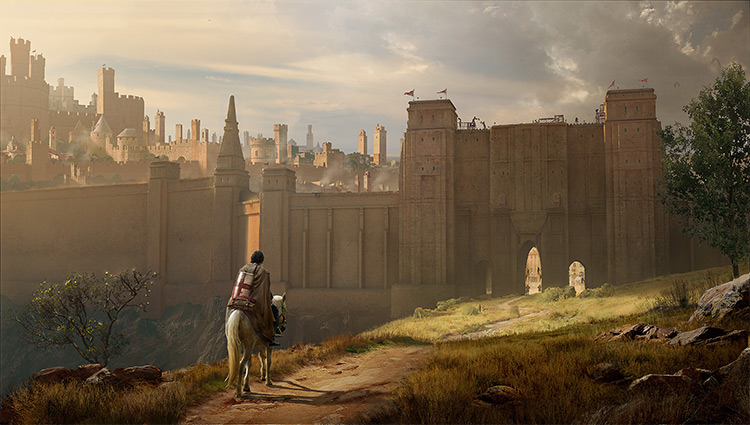Santaterra
"Between the constant chants coming from the temples, the town criers, the itinerant priests, and the merchants shouting their wares, and the smell of saffron, incense and horse-dung, I don't know who can stand being in the streets for too long..." Galuh Kadrier of the Faraway Eyes
Considered by the citizens of the Crimson Lands to be the Holiest of cities, and by the Tetrarchy of Faith to be the seat of their church, Santaterra is not only the first city of the Crimson Lands, it is also the one place in which member of the Faith reignited the kindle of their zeal. Today, it stands in a strange crossroads, as now more and more people have began to drift away from the Faith, and began to perhaps dip their toes in the Old Faith, and even in druidism, things which the Inquisitors of the Tetrarchy are not happy with.
Other than that, the city is one of the main port-cities of the Iron Coast, and while it is not an important trading hub of the Crimson Lands (that would be Lagomia, or even Barza), Santaterra connects with the other coastal cities of the land, such as Ilbiza, Puertobueno and Puertomalo, besides also being a site of holy pilgrimages.
Demographics
Humans, Halfings, and a few half-elves and a few half-orcs and orcs that came from the Northlands
Government
While the government is ruled by a constitutional monarchy, with the King being elected from a group of Marshals of the different militant orders of the Faith, the city is more or less ruled by St. Cuthbert indirectly.
Defences
The city is overseen by the Castle of the High King of Santaterra in the distance, which hosts several men-at-arms, pages, and a few knights and templars, while also there are two distinct walls protecting the city: The Main Wall, known as the Wall of Faith, recently finished, is a massive granite wall with stout towers and battlements, and the smaller Peasant Wall, which was built in the foundation of the city.
Industry & Trade
The city is usually considered a pilgrimage site, as the city is the home of the Faith, and several petitioners come here to be let into the many penitent monasteries, militant orders, and flagellant societies of the Faith. Additionally, this is also a place of learning for many, and while it may be not as cosmopolitan as Twelve-Tower City , it does have a Royal Academy of Artificers, recently sanctioned by the King himself, but there is also several more mundane colleges of Sciences and History, guilds of assorted craftsmen, and mercantile guilds.
Infrastructure
The city has a well-established pier, with ships coming in and sailing away daily, so there are plenty of different cranes, pulleys and other contraptions (even the odd automata) helping with crates, barrels and other cargo. The Main Street, sometimes called "The Knight's Way" is wide enough to have two dozen or so knights riding out with Destriers, all with their barding and equipment; however, the Knight's Way shrinks awfully quick once you get to the market areas, or the Beggar's Gate.
Guilds and Factions
As most cities, there are several guilds of smaller trades which are determine who works where and in what.
History
n the year 1712, the first stones of Santaterra would be placed, and the wood and other materials used for the ships were repurposed to make docks, tools, wooden beams for houses, and even a small temple of the Faith. In time, people of the Southlands (whom the Crimson People called Bernuinos at the time) began to arrive, and some established trade relations with them, or offer aid as long as they helped them in battle.
In 1717, diplomats of both Twelve-Tower City and some of the cities of The Valley Princes would arrive at Santaterra, and establish diplomatic relations.
Architecture
The general impression given by architecture Santaterra (and most cities of the Crimson Lands in general), in both ecclesiastical and secular buildings, is one of massive solidity and strength: The walls of buildings are often of massive thickness with few and comparatively small openings. They are often double shells, filled with rubble.
Because of the massive nature of the walls, buttresses are not a highly significant feature, these are generally of flat square profile and do not project a great deal beyond the wall. In the case of aisled temples, barrel vaults, or half-barrel vaults over the aisles helped to buttress the nave, if it was vaulted.
Geography
The City overlooks the Iron Coast, and it is known to have very dramatic sunsets, while the land surrounding it seems harsh and hot at first glance; but there are plenty of farmlands.
Natural Resources
Besides the obvious bounty of the oceans (the Icon Coast is rich in shrimp, lobsters, and other assorted fish and oysters), the farmlands surrounding the city grow olives (brought from the Westernlands), Tomatoes, Oranges, wheat, Saffron (also from the Westernlands), rice, and mild chilies (brought from as far as Axtalan and potatoes from the Wiitskaal Mountains.
Alternative Name(s)
The Holy City, The Seat of the Three, The Seat of the Faith
Type
City
Population
15'386
Location under
Owning Organization
Remove these ads. Join the Worldbuilders Guild










Comments